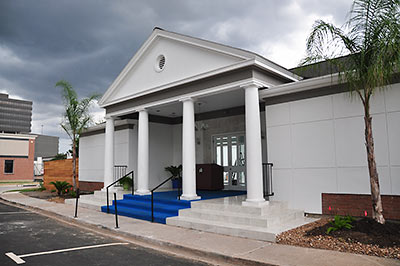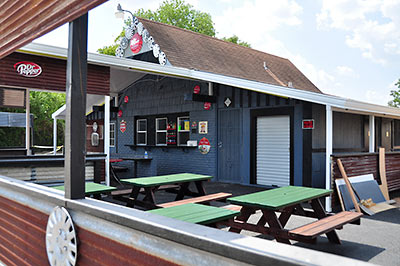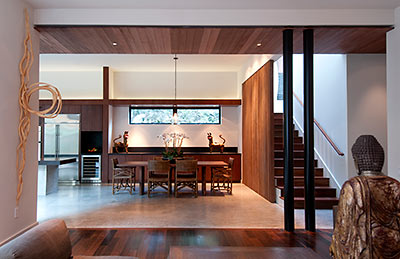ORTHODOX SYNAGOGUE MULLS CROSSING THE LOOP TO SOMEWHAT HIGHER GROUND  The roughly 820 homeowners in Willow Meadows are now voting on a deed restriction change that — if passed — would allow the United Orthodox Synagogue to build a new structure outside The Loop, in place of 5 houses that sit 3 quarters of a mile south down Greenwillow St. from the congregation’s previous home at the corner of S. Braeswood. Many congregants walk to the synagogue — which could soon be leaving the 100-year floodplain for the 500 after flooding 6 times in the last 25 years, including 3 in the last 3. “According to preliminary renderings,” reports the Jewish Herald Voice’s Michael C. Duke on Studio Red’s proposed design, “the synagogue would be a single-story structure, measuring an ultimate height of 30 feet. Based on new building codes, the finished floor of the building would be built some 3 feet above curb height, and the building itself would have the same 25-foot setback as homes in Willow Meadows.” Passage of the proposal “would prompt Houston’s largest Orthodox congregation to hold its own congregation-wide vote on whether to stay at its current location north of I-610 South and rebuild portions of its campus at a significantly higher elevation; or, to move.” Most of the congregation’s 57-year-old building was demolished last month, except for a few portions including its social hall and mikvah. [Jewish Herald Voice; previously on Swamplot] Photo of United Orthodox Synagogue’s demolition, 9001 Greenwillow St.: United Orthodox Synagogues of Houston
The roughly 820 homeowners in Willow Meadows are now voting on a deed restriction change that — if passed — would allow the United Orthodox Synagogue to build a new structure outside The Loop, in place of 5 houses that sit 3 quarters of a mile south down Greenwillow St. from the congregation’s previous home at the corner of S. Braeswood. Many congregants walk to the synagogue — which could soon be leaving the 100-year floodplain for the 500 after flooding 6 times in the last 25 years, including 3 in the last 3. “According to preliminary renderings,” reports the Jewish Herald Voice’s Michael C. Duke on Studio Red’s proposed design, “the synagogue would be a single-story structure, measuring an ultimate height of 30 feet. Based on new building codes, the finished floor of the building would be built some 3 feet above curb height, and the building itself would have the same 25-foot setback as homes in Willow Meadows.” Passage of the proposal “would prompt Houston’s largest Orthodox congregation to hold its own congregation-wide vote on whether to stay at its current location north of I-610 South and rebuild portions of its campus at a significantly higher elevation; or, to move.” Most of the congregation’s 57-year-old building was demolished last month, except for a few portions including its social hall and mikvah. [Jewish Herald Voice; previously on Swamplot] Photo of United Orthodox Synagogue’s demolition, 9001 Greenwillow St.: United Orthodox Synagogues of Houston
Tag: Deed Restrictions
GARDEN OAKS MAINTENANCE ORGANIZATION LIKELY TO FILE FOR BANKRUPTCY ON ACCOUNT OF ALL THAT MONEY IT HAS IN THE BANK  The Garden Oaks Maintenance Organization has hired a law firm to handle an anticipated bankruptcy filing — which could come as soon as Monday, reports The Leader’s Jonathan McElvy. Two years ago, a lawsuit that the organization had filed to enforce its deed restrictions against a pair of homeowners backfired when the court ruled that GOMO itself had not been formed legally. (An appeals court has since ruled that it does still have power to enforce the neighborhood’s bylaws.) As a result, in the wake of the initial ruling, “every dollar GOMO spends now could be challenged in court,†writes McElvy. With close to $600,000 in its bank account, GOMO now appears to face 2 options, he notes: “Either the board disbands and lets a judge tell them how to disburse that money, or they try a legal maneuver that seeks a judge’s permission to reorganize, so they can continue operations as the gatekeeper of Garden Oaks.†If this story sounds vaguely familiar, it’s because it is. GOMO’s predecessor entity was disbanded before the current organization began in 2001 because it was, McElvy says, “formed illegally, as well.” [The Leader; previously on Swamplot] Photo: Swamplot inbox
The Garden Oaks Maintenance Organization has hired a law firm to handle an anticipated bankruptcy filing — which could come as soon as Monday, reports The Leader’s Jonathan McElvy. Two years ago, a lawsuit that the organization had filed to enforce its deed restrictions against a pair of homeowners backfired when the court ruled that GOMO itself had not been formed legally. (An appeals court has since ruled that it does still have power to enforce the neighborhood’s bylaws.) As a result, in the wake of the initial ruling, “every dollar GOMO spends now could be challenged in court,†writes McElvy. With close to $600,000 in its bank account, GOMO now appears to face 2 options, he notes: “Either the board disbands and lets a judge tell them how to disburse that money, or they try a legal maneuver that seeks a judge’s permission to reorganize, so they can continue operations as the gatekeeper of Garden Oaks.†If this story sounds vaguely familiar, it’s because it is. GOMO’s predecessor entity was disbanded before the current organization began in 2001 because it was, McElvy says, “formed illegally, as well.” [The Leader; previously on Swamplot] Photo: Swamplot inbox
COMMENT OF THE DAY: YOUR VERY OWN INNER LOOP TRAILER PARK, FOR FUN AND PROPERTY TAX CONTROL  “Are there typically HOA restrictions against mobile homes inside the Loop? Like if someone’s sitting on a cleared-off lot and not wanting to build, could they just pull in 2 mobile homes and start renting out? Or would the neighborhood/city be pounding on the doors? Not sure such a thing is feasible with $400k lots, but if you had to demo a multifamily and still wanted to hold onto the property, sounds like [that] could potentially keep the tax value low while still bringing in rental income.” [joel, commenting on All That’s Left of the Heights Trailer Park Behind Eight Row Flint] Photo of cleared mobile home park on W. 11th St.: Swamplot inbox
“Are there typically HOA restrictions against mobile homes inside the Loop? Like if someone’s sitting on a cleared-off lot and not wanting to build, could they just pull in 2 mobile homes and start renting out? Or would the neighborhood/city be pounding on the doors? Not sure such a thing is feasible with $400k lots, but if you had to demo a multifamily and still wanted to hold onto the property, sounds like [that] could potentially keep the tax value low while still bringing in rental income.” [joel, commenting on All That’s Left of the Heights Trailer Park Behind Eight Row Flint] Photo of cleared mobile home park on W. 11th St.: Swamplot inbox
COMMENT OF THE DAY: A GUESS AT PROPER ETIQUETTE FOR OUT-OF-FASHION DEED RESTRICTIONS  “My old neighborhood – two houses ago – should be very worried as well. Right before I got there, some people had tried to rewrite the deed restrictions. Some other people blocked the rewrite. Which basically meant that the old restrictions – from the 1950s – were still in force – or were they? Half the regulations were either moot (who has a garbage incinerator in their back yards nowadays?) or illegal today. But more importantly: the restrictions were supposed to have been renewed in the 1970s and again in the 1990s, but it’s not clear they ever were. I wound up basically following the practical rule that whatever the county clerk has on record is in force whether it makes sense or not, so long as it is not rendered illegal by some other law. But I am not a lawyer, and I know that approach probably would not hold up in court.” [ZAW, commenting on Comment of the Day: Garden Oaks Question Marks Raise Question Marks Citywide] Illustration: Lulu
“My old neighborhood – two houses ago – should be very worried as well. Right before I got there, some people had tried to rewrite the deed restrictions. Some other people blocked the rewrite. Which basically meant that the old restrictions – from the 1950s – were still in force – or were they? Half the regulations were either moot (who has a garbage incinerator in their back yards nowadays?) or illegal today. But more importantly: the restrictions were supposed to have been renewed in the 1970s and again in the 1990s, but it’s not clear they ever were. I wound up basically following the practical rule that whatever the county clerk has on record is in force whether it makes sense or not, so long as it is not rendered illegal by some other law. But I am not a lawyer, and I know that approach probably would not hold up in court.” [ZAW, commenting on Comment of the Day: Garden Oaks Question Marks Raise Question Marks Citywide] Illustration: Lulu

What’s the story behind the tiny question marks that recently appeared at the end of the low-dangling “DEED RESTRICTIONS ENFORCED” signs on at least a couple Garden Oaks welcome-to-the-neighborhood markers? More than just your usual neighborhood grumbling and graffiti-ing, it appears.
COMMENT OF THE DAY: 2 ONE-WAY TRAJECTORIES FOR HOUSTON TOWNHOME DEVELOPMENT  ” . . . The big concern that I have about townhomes is that perhaps about 15 to 30 years out, and as they start to show their age in the predictable ways (never mind the less predictable ways that relate to the regional economy or transportation), that some individual owners in fee simple arrangements will shirk repairs and bring down entire clusters or neighborhoods. They are different from condo regimes in that way, but also in another: fractured land ownership and deed restrictions make redevelopment and land use change basically impossible. Forever. It’s possible that state laws and municipal ordinances would change to cope with things, or that Houston will become so affluent as to render the concern moot, but I see it as a risk.” [TheNiche, commenting on Raising the Bar for Upscale Housing; A New Hospital for Galveston] Illustration: Lulu
” . . . The big concern that I have about townhomes is that perhaps about 15 to 30 years out, and as they start to show their age in the predictable ways (never mind the less predictable ways that relate to the regional economy or transportation), that some individual owners in fee simple arrangements will shirk repairs and bring down entire clusters or neighborhoods. They are different from condo regimes in that way, but also in another: fractured land ownership and deed restrictions make redevelopment and land use change basically impossible. Forever. It’s possible that state laws and municipal ordinances would change to cope with things, or that Houston will become so affluent as to render the concern moot, but I see it as a risk.” [TheNiche, commenting on Raising the Bar for Upscale Housing; A New Hospital for Galveston] Illustration: Lulu
COMMENT OF THE DAY: HOW TO BUILD A NEIGHBORHOOD MOAT WITH DEED RESTRICTIONS  “Instead of throwing lawsuits around, the people in River Oaks should start a Buy Protect Sell program. Buy pieces of land around their subdivision as they come up for sale. Protect those pieces of land by putting restrictive covenants on them (height regulations in particular, since their concern has been the proliferation of high rises in their area). Then sell the properties with the restrictions in place.
B/P/S has been used for about a decade by environmentalists elsewhere in the country. It could be used to preserve the low-rise character around a neighborhood. The drawback is that it can be costly for poorer neighborhoods, but River Oaks could well afford it.” [ZAW, commenting on Neighbors File Suit To Stop Hines San Felipe Tower; Silo Sightseeing] Illustration: Lulu
“Instead of throwing lawsuits around, the people in River Oaks should start a Buy Protect Sell program. Buy pieces of land around their subdivision as they come up for sale. Protect those pieces of land by putting restrictive covenants on them (height regulations in particular, since their concern has been the proliferation of high rises in their area). Then sell the properties with the restrictions in place.
B/P/S has been used for about a decade by environmentalists elsewhere in the country. It could be used to preserve the low-rise character around a neighborhood. The drawback is that it can be costly for poorer neighborhoods, but River Oaks could well afford it.” [ZAW, commenting on Neighbors File Suit To Stop Hines San Felipe Tower; Silo Sightseeing] Illustration: Lulu
HOW EASY IS IT TO GET OUT OF IDYLWOOD?  A reader wonders if subdividing lots might get you new subdivision rules: “There is a great big ole sign [pictured at right] in the vacant lot at 6636 Meadowlawn in Idylwood. It is a notice of a request to replat the lot into two single family lots. It is plenty large enough, being one full lot and parts of the two lots on either side. As it stands, I can understand why they’d want to replat. The company that bought the property is Nadco LLC.
That in itself is not so strange but what is strange is that the sign also says that the two new lots will create a new subdivision known as Idylwood Partial Replat #1.
. . . I’m wondering if the ‘new subdivision’ would be subject to Idylwood deed restrictions or if they could totally disregard setbacks and lot lines among other things.” [Swamplot inbox; previously on Swamplot] Photo: Swamplot inbox
A reader wonders if subdividing lots might get you new subdivision rules: “There is a great big ole sign [pictured at right] in the vacant lot at 6636 Meadowlawn in Idylwood. It is a notice of a request to replat the lot into two single family lots. It is plenty large enough, being one full lot and parts of the two lots on either side. As it stands, I can understand why they’d want to replat. The company that bought the property is Nadco LLC.
That in itself is not so strange but what is strange is that the sign also says that the two new lots will create a new subdivision known as Idylwood Partial Replat #1.
. . . I’m wondering if the ‘new subdivision’ would be subject to Idylwood deed restrictions or if they could totally disregard setbacks and lot lines among other things.” [Swamplot inbox; previously on Swamplot] Photo: Swamplot inbox

The verdicts handed down this week in the court case connected to a dispute between the owners of 3 bars carved out of the former Settegast Kopf funeral home on Kirby Dr. at Colquitt, their landlord, and residents of the subdivision that surrounds it are a tad complicated. As a result of the jury decisions, neighborhood homeowners are now asking the judge to force 2 of the bars — Roak and Hendricks Pub — to stop selling alcohol. One of the jurors in the case offers Swamplot readers a detailed explanation of the decision:
JUDGE TO HOA: YOUR POTBELLIED NEIGHBOR CAN STAY  60-lb. porcine Spring resident Wilbur Sardo will not be exiled from The Thicket at Cypresswood subdivision — because his presence in the neighborhood does not violate the local deed restrictions, a Harris County judge ruled today. The pig’s attorney, HOA law specialist Mitchell Katine, tells Chronicle reporter Erin Mulvaney that the decision in the lawsuit filed by the animal’s owners marks “the first time a Vietnamese pot belly pig has been recognized as a pet in court.” The neighborhood’s community improvement association had argued that Wilbur counted as livestock, and was therefore prohibited. The Sardo family began an extensive media campaign around its quest to keep Wilbur after receiving a notice from the association last year that it would be subject to fines of $200 a day if it continued to keep their pet at home. [NewsWatch; previously on Swamplot] Photo: iWilbur.com
60-lb. porcine Spring resident Wilbur Sardo will not be exiled from The Thicket at Cypresswood subdivision — because his presence in the neighborhood does not violate the local deed restrictions, a Harris County judge ruled today. The pig’s attorney, HOA law specialist Mitchell Katine, tells Chronicle reporter Erin Mulvaney that the decision in the lawsuit filed by the animal’s owners marks “the first time a Vietnamese pot belly pig has been recognized as a pet in court.” The neighborhood’s community improvement association had argued that Wilbur counted as livestock, and was therefore prohibited. The Sardo family began an extensive media campaign around its quest to keep Wilbur after receiving a notice from the association last year that it would be subject to fines of $200 a day if it continued to keep their pet at home. [NewsWatch; previously on Swamplot] Photo: iWilbur.com
COMMENT OF THE DAY: COMES WITH THE LAND “If you take the Houston blinders off for a minute, you’ll realize that ‘deed restrictions protect property values’ and ‘zoning distorts property values’ are the same statement. Other things that ‘distort’ property values are: having a functioning police force so you have a reasonable certainty that a band of pirates won’t come steal everything you own; having roads to connect your property to other things; being located in a country with a functioning economy; public support of decent schools; a public health system that prevents outbreaks of Ebola; lack of a brutal murderous dictatorial regime; and not living downwind of a sewage treatment plant. Which of these are ‘evil planning’ vs ‘sensible government’ is, of course, determined by the political views of the speaker.” [John (another one), commenting on Comment of the Day: Keep Houston Cheap]

“Veterinary experts” are now “standing by to testify” in the lawsuit filed yesterday against a Spring HOA on behalf of Houston’s best-known potbellied pig, declares the lawyer hired by the pig’s owners, Missy and Alex Sardo. What’ll those experts say? That Wilbur Sardo, the 60-lb. pet with close to 5,000 Facebook friends — and now a live webcam show — doesn’t count as livestock, and therefore isn’t prohibited from living with his owners by the deed restrictions of the Thicket at Cypresswood neighborhood.
Pot-bellied pig Wilbur Sardo now has more than 3300 friends on Facebook, a Twitter feed, a growing YouTube channel, and an online petition with more than 500 supporting signatures, but still only 17 days left before he’ll have to find a new home outside The Thicket at Cypresswood subdivision in Spring. Owner Missy Sardo says she was told at an HOA meeting and over the phone last week that she could keep her household pet if she got 51 percent of residents to sign a petition in the pig’s favor. But a certified letter Sardo received over the weekend indicates that the neighborhood’s board of directors has decided that its “initial decision [to banish the pig] will stand.” The neighborhood’s deed restrictions prohibit “animals, livestock, poultry, reptiles, or insects of any kind.” Household pets, defined as “domestic animals commonly and traditionally kept in homes as pets” are allowed, as long as they do not include “any wild, semi-wild, or semi-domesticated animal.”
- Spring family fighting to keep pet pig says HOA won’t budge, despite petition [KHOU]
- Save Wilbur Sardo
- Deed Restrictions excerpt (PDF) [Save Wilbur Sardo]
- Wilbur Sardo [Facebook]
- Previously on Swamplot: Some Pig
Video: Wilbur Sardo

 The almost here, the already here, and the soon-to-be-departed:
The almost here, the already here, and the soon-to-be-departed:
- Opening Soon: City inspection issues having been conquered, Hubcap Grill‘s new Heights-ish outpost in Shady Acres is now aiming for an opening “mid/late” next week, tweets burger-slinger Ricky Craig. The converted drive-up at 1133 W. 19th St. is just around the corner from Cedar Creek. Plenty more patio seating in back.
- Already Open: So sorry you missed the christenings, but the nightclub, restaurant-bar, and wading pool carved out of the former Settegast Kopf funeral home at 3320 Kirby, have been open and holding events for a week or 2 already. That place wearing its paneling on the outside is Hendricks Pub and Eatery. Roak is the nightclub; the atrium pool has its own name: Rush. The bars and their neighbors in the David Crockett subdivision immediately to the west will have plenty of time to become acquainted with each other before their court date next May. Some local residents have filed suit against the bars’ owners, claiming the clubs are in violation of local deed restrictions:

 Included in the $1,470,000 asking price of this just-finished 3-bedroom, 3-1/2 bath house in the northern reaches of Boulevard Oaks: a pair of doors from a 19th-century house near Osaka; that Chinese wine pot (of similar vintage) sitting at the end of the central hall by the kitchen; a 46†Sony Edgelit TV; those planters on the back terrace; the dining room table and chairs; and of course the coffee table, upholstered pieces, and Buddha in the living room. “Many of my buyers have relocated to Houston without anything to sit on,” explains developer Carol Isaak Barden.
Included in the $1,470,000 asking price of this just-finished 3-bedroom, 3-1/2 bath house in the northern reaches of Boulevard Oaks: a pair of doors from a 19th-century house near Osaka; that Chinese wine pot (of similar vintage) sitting at the end of the central hall by the kitchen; a 46†Sony Edgelit TV; those planters on the back terrace; the dining room table and chairs; and of course the coffee table, upholstered pieces, and Buddha in the living room. “Many of my buyers have relocated to Houston without anything to sit on,” explains developer Carol Isaak Barden.
Barden’s house replacement at 1916 Banks St. is the 15th project she’s built to sell — if you count each townhouse in her earlier multi-unit ventures separately — and the second one designed by Seattle architect Rick Sundberg. Sundberg, who’s since left to start a new firm with his daughter, was still with Olson Sundberg Kundig Allen when he designed Barden’s Wabi Sabi house a few years ago (they’re now down to Olson Kundig without him). Barden called this house Wabi Sabi II until she started spending a lot of time coordinating the work of local designers and craftsmen on the project.

